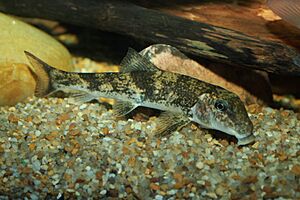Northern hogsucker facts for kids
Quick facts for kids Northern hogsucker |
|
|---|---|
 |
|
| Conservation status | |
| Scientific classification | |
| Synonyms | |
|
The northern hogsucker (Hypentelium nigricans) is a type of freshwater fish. It belongs to the Catostomidae family, which are also known as "suckers." This fish lives in streams and rivers across the United States and Canada.
Northern hogsuckers like clear, fast-moving water. They search for food on the riverbed. Their diet includes small crabs, snails, water insects, and algae. They are known for turning over small rocks and scraping food off surfaces. Other fish sometimes wait downstream to catch food that the hogsucker stirs up.
Contents
Where Northern Hogsuckers Live
The northern hogsucker lives in southern Canada and much of the eastern and southern United States. You can find them in the rivers of the Mississippi River Basin. Their range stretches from Oklahoma and Alabama up to Minnesota. They also live in the Great Lakes and rivers along the mid-Atlantic coast.
This fish usually lives in or near fast-moving parts of warm water creeks and small rivers. They can also be found in cold streams, tiny creeks, and large rivers. Sometimes, they even appear in reservoirs.
Northern Hogsucker Life Cycle
Male northern hogsuckers can become ready to have babies when they are two years old. Females usually mature a bit later, around three years old. Fish living in smaller streams tend to be smaller and take longer to grow up.
A northern hogsucker can grow up to 33 cm (13 in) long by the time it is five years old. The biggest hogsuckers are usually females. These fish can live for about eleven years.
What Northern Hogsuckers Eat
Northern hogsuckers mostly eat insect larvae, small crustaceans, and snails. They also munch on tiny algae and bits of plants. When they eat, they scrape the top layer off rocks. They also flip over stones on the river bottom. Then, they suck up the loose material, which contains many small creatures.
As the hogsucker feeds, other fish often gather downstream. Fish like shiners and smallmouth bass wait to catch any food that the hogsucker uncovers.
Who Eats Northern Hogsuckers?
Young northern hogsuckers in shallow, fast-moving streams can be eaten by fish that hunt other fish. As they grow older, they become some of the larger fish in their waterways. In the northern parts of their range, where they live in deeper streams and lakes, bigger fish like Muskellunge and Northern pike might hunt them.
Sometimes, northern hogsuckers compete with other types of sucker fish for places to lay their eggs. When hogsuckers are laying eggs, smaller fish like daces, minnows, and chubs might try to eat the freshly laid eggs.
Reproduction
Northern hogsuckers usually lay their eggs in shallow, fast-moving parts of rivers called riffles. This often happens in May, when the water temperature is about 15 °C (59 °F). Male hogsuckers gather over these gravel areas. Several males might try to court one female.
The egg-laying process is quite active, and the fish create small dips in the gravel from all the movement. The eggs are not sticky and simply settle down onto the gravel. Young hogsuckers and baby fish swim in groups. They prefer shallower water (less than 30 cm deep) than the adult fish.
Northern Hogsuckers and Humans
Even though the northern hogsucker is not currently on any endangered lists, it can still be affected by human activities. Things like changing river paths (channelization), too much dirt in the water (sedimentation), pollution, and building dams can harm their populations.
It's important to make sure there are enough good places for them to lay eggs in the future. Sedimentation, which is when dirt and sand build up, can ruin their living and breeding areas. Changes in water temperature from city runoff can also be a problem for their homes.
You can find H. nigricans in national and state parks. The Great Smoky Mountains National Park is one example. They are common in all streams in that park up to 2,800 feet (850 m) high. In parks, they are protected.
The northern hogsucker is a common fish across its wide range. No major threats have been found for it. Because of this, the International Union for Conservation for Nature says its conservation status is "least concern." This means it's not currently at risk of disappearing. The world record for a northern hogsucker caught by a fisherman was 1.47 kg (3 lb 4 oz). This fish was caught near St Cloud, Minnesota in 2023.


